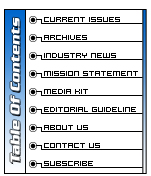|
Satellite Imagery in Hydrogeologic Studies
By Daniel Hart Remote sensing is the use of the electromagnetic spectrum to inventory resources, monitor the environment, solve problems, and plan future actions. There are roughly two-dozen remote sensing applications operational in the field of hydrology. Satellite imagery has been available since the early 1970s but is often overlooked as a powerful and cost effective tool in hydrogeologic studies. Water Management Consultants has successfully used satellite imagery for a variety of purposes in these studies in North and South America.
Basic false-color Landsat images may be utilized in hydrogeologic studies for enhancing the understanding of geology and geomorphology, and inventorying surface waters and associated features. The quality of interpretations varies with the amount of vegetation cover in the area of interest. Interpretations are improved when carried out in conjunction with existing topographic, geologic, hydrologic, cultural, and other mapped data.
An understanding of regional geology is critical to the correct conceptualization of a regional groundwater flow system, the first step in most hydrogeologic studies. Geologic interpretations of satellite images include discrimination of alluvial and bedrock areas, lithologic mapping, mapping of areas of alteration in bedrock, and delineation of regional geologic structures.
Several geomorphologic interpretations of satellite imagery also contribute to the conceptualization of regional and site hydrogeologic models. These may include definition of basin geometry, identification of flood plains, identification of modern and paleo-stream channels and shorelines, interpretation of land forms, drainage patterns and density (texture), vegetation patterns, and delineation of land use, land cover, and soil type.
A rapid inventory of surface water resources is possible using satellite imagery. Ground truthing and follow-up efforts can be focused based on the imagery interpretations, thereby making the best use of time and budget. Imagery can be used effectively to inventory reservoirs, lakes, and ponds, locate large seeps and springs, delineate areas of snow coverage, record seasonal changes in areas of water or soil moisture, and help identify recharge and discharge areas.
Other hydrogeologic interpretations are possible with more sophisticated processing of the data. These include measurement of water turbidity, detection of thermal patterns in surface water bodies, estimation of moisture content of surface and near-surface soils, classification of salt surfaces, and others. These other applications often require calibration with field measurements.
Satellite imagery is a valuable resource for groundwater exploration, regional and site hydrogeologic characterizations, and water resource evaluation. Imagery interpretations contribute to identification of areas for water rights acquisition, screening of areas for more detailed ground geophysical investigations, drill site targeting for groundwater exploration or for monitoring wells, and provide input to hydrogeologic models and watershed analyses.
Water Management Consultants has applied Landsat imagery to regional and local water supply exploration, mine dewatering investigations, siting of monitoring wells for industrial facilities, general hydrogeologic site characterizations for groundwater modeling projects, and brine mining studies. Most of these studies have placed emphasis on defining the structural and general geologic framework of the areas of interest. Advanced processing of Landsat data has been carried out for the brine mining projects. For a project in a densely vegetated region, the Landsat image was combined with radar data in order to provide better definition of the land surface. All of these projects have incorporated the best available geologic, geophysical, and other mapping data from public and client sources. Areas of application include Chile, Peru, Bolivia, Venezuela, Mexico, and the western US, including Alaska. In many of these areas geologic mapping was not available, or existed only at a small scale. In some cases, even topographic coverage was deficient.
Images are also useful as base maps for drawings and for planning of site investigations, particularly where topographic or geologic map coverage is unavailable or available at an inadequate scale. Satellite imagery may be readily incorporated as a layer in a GIS or in AutoCad, since the data are in digital format. The quality and efficiency of hydrogeologic interpretations is greatly enhanced because of the map-based data visualization capability offered by a GIS system.
The advantages of satellite imagery compared with aerial photography include the ability to use the photo in digital format, ease of re-scaling, spatial accuracy (when geo-rectified), ease of use (a large area can be displayed on one print), faster acquisition, and cost savings. The only significant disadvantage is a lower resolution than most aerial photos. Satellite imagery is, therefore, best suited to sub-regional to regional scale investigations, but is a good supplement to site specific studies.
Landsat imagery is available for the whole world between the latitudes of 81N and 81S. New data has been acquired for this area every 16 days since 1972. Each scene covers approximately 185x185km (approximately 35,000km2). Landsat sensors acquire spectral data for 7 bands. Resolution is approximately 30 meters, except for band 6 which is 120m.
A "false color" composite image using bands 7, 4, and 1 (assigned to colors red, green, and blue respectively) is commonly used for Earth resource applications. Using this band-color assignment, water appears as shades of blue, vegetation as green, and dry land as red, brown, and black tones. Highly reflective areas appear bright (clouds appear white), and non-reflective areas appear dark (dry rocks and heavily shadowed areas appear black).
An output scale of 1:100,000 is often used for regional interpretations, but useable output scales of up to 1:50,000 are possible. A 1/4-scene standard false color print, covering approximately 90x90km is generally adequate for site investigations and can be obtained for as little as $1,000 ($0.11/km2 or $0.30/mi2). Image costs vary with the supplier, age of the data (10+ year old data are cheaper), size and type of print (photo or plotter), and additional processing that may be required. Often, the cost of the imagery can be shared by other project applications (such as mineral exploration), making satellite imagery an extremely good value in consideration of the potential benefits to hydrogeologic investigations. About the Author:
Daniel Hart, r.g., is a specialist hydrogeologist for Water Management Consultants, Inc.
Back
|

